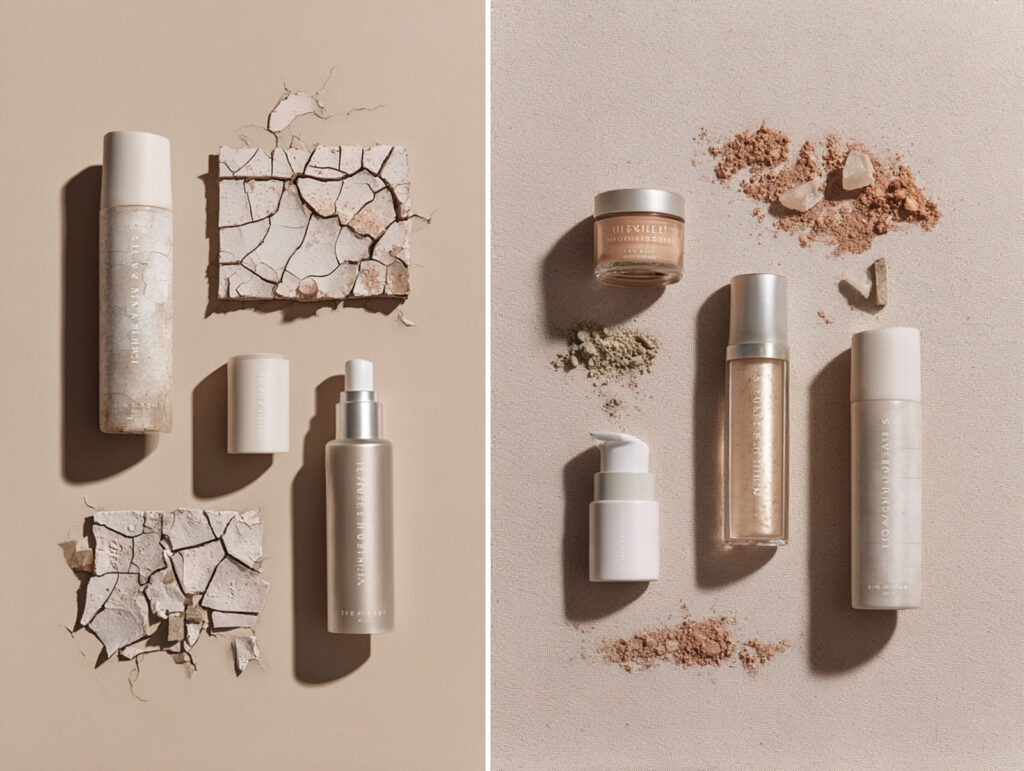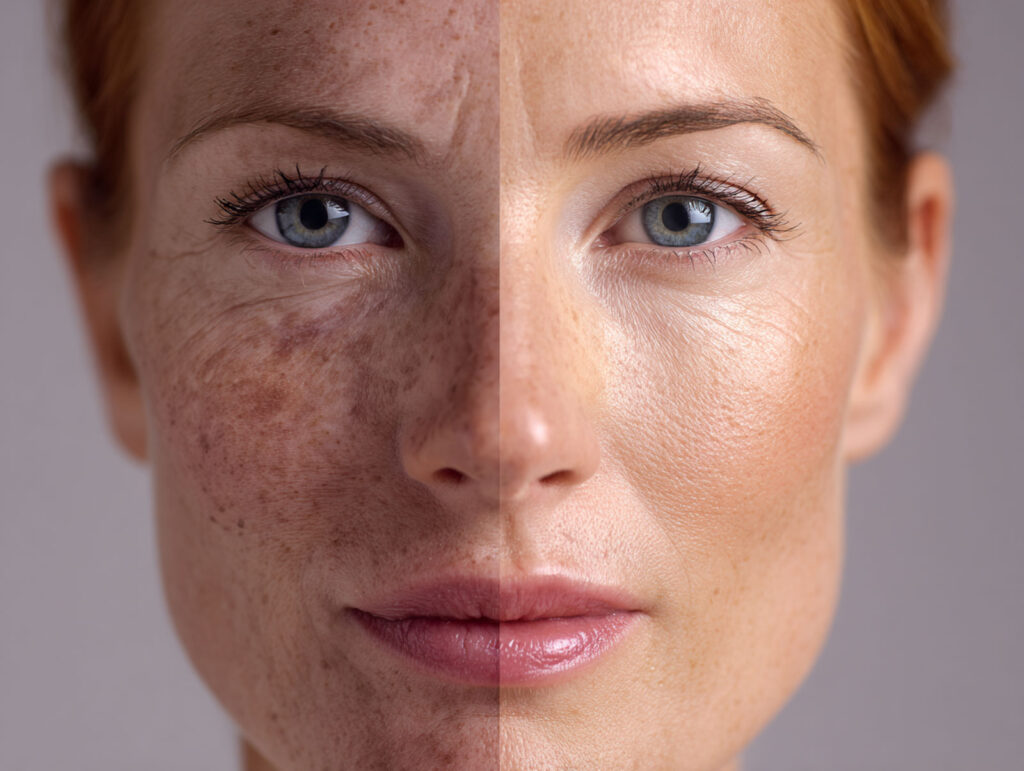Professional Skincare, Skincare
Top 10 Skincare Myths Debunked
Skincare advice comes at us from all directions – friends, influencers, magazines, brands, even well-meaning estheticians. But not everything we’ve been told is true. Some of the most widely believed skincare “facts” are actually myths and following them can hold your skin back or even harm it. In this article, I’m walking through ten of the most persistent skincare myths, backed by real research and professional consensus – not trends or guesses.
We’re cutting through the noise. No fluff. No fads. Just facts.
Myth 1: Oily skin doesn’t need moisturizer
This one might feel logical on the surface – why add more moisture to already shiny skin? But the truth is that oily skin can still be dehydrated. And when the skin lacks water, it may produce even more oil to compensate.
Oily skin types often benefit most from lightweight, oil-free moisturizers that restore hydration without clogging pores. Skipping moisturizer can disrupt the skin barrier, making conditions like acne or seborrheic dermatitis worse.
A 2018 review published in the Journal of Clinical and Aesthetic Dermatology emphasized that moisturizers are essential even for oily or acne-prone skin to maintain skin barrier function and reduce irritation from treatments like benzoyl peroxide or retinoids (https://www.ncbi.nlm.nih.gov/pmc/articles/PMC5796020/).
Myth 2: You don’t need sunscreen on cloudy days or indoors
UV rays aren’t blocked by clouds, and UVA rays – responsible for premature aging and deep skin damage – can penetrate glass. This means your skin is still at risk while driving, sitting near a window, or even during a gloomy afternoon.
According to the Skin Cancer Foundation, up to 80% of UV rays can pass through clouds, and UVA rays can penetrate both clouds and glass (https://www.skincancer.org/skin-cancer-prevention/sun-protection/sunscreen/).
Daily sunscreen use has been shown to prevent not just skin cancer but also visible signs of aging. And yet, many people still skip it unless they’re planning a beach day.
Myth 3: Natural ingredients are always safer and better than synthetic ones
The idea that “natural” equals safe and “chemical” equals harmful is one of the most pervasive myths in skincare. Arsenic is natural. Poison ivy is natural. Not everything from nature is good for your skin.
Conversely, many synthetic ingredients are carefully designed for safety, stability, and effectiveness. Lab-made vitamin C (ascorbic acid), for instance, is molecularly identical to the vitamin C found in fruits but more stable in formulations.
Dermatologists and toxicologists agree that ingredient safety depends on concentration, usage, and individual sensitivity – not origin. The Environmental Working Group, while often cited for natural advocacy, also acknowledges that natural products can trigger allergies or reactions just as synthetic ones can.

Myth 4: You can shrink your pores
Pore size is largely determined by genetics and skin type. While some products and treatments can minimize the appearance of pores, they don’t actually make them physically smaller.
What does help: exfoliating acids like salicylic acid to clear out pore-clogging debris, retinoids to regulate skin cell turnover, and sun protection to prevent collagen loss that can make pores appear larger over time.
A 2016 study published in Dermatologic Surgery reviewed treatments for enlarged pores and concluded that while various therapies can improve the appearance of pores, no permanent reduction in pore size was possible (https://pubmed.ncbi.nlm.nih.gov/27416168/).
Myth 5: If it burns or tingles, it means it’s working
A tingling sensation is often interpreted as a sign of a product “activating” or “penetrating” the skin. But in reality, burning or stinging is usually a red flag. It can signal irritation, allergic reaction, or a damaged skin barrier.
There are exceptions – some active ingredients like exfoliating acids or prescription retinoids may cause temporary tingling as your skin adjusts. But a persistent burning feeling isn’t something to push through. It’s a sign to back off.
According to the American Academy of Dermatology, any product that causes persistent burning should be discontinued, and a patch test is advised when trying new formulas (https://www.aad.org/public/everyday-care/irritated-skin/patch-test).
Myth 6: Acne is caused by dirty skin
Acne isn’t about hygiene. It’s a complex inflammatory condition influenced by hormones, oil production, bacteria (specifically Cutibacterium acnes), and genetics. Over washing can actually make acne worse by stripping the skin and triggering more oil production.
Using harsh cleansers or scrubbing aggressively will not “clean out” acne – it will likely inflame the skin and damage the barrier, which can lead to more breakouts and post-inflammatory hyperpigmentation.
The American Academy of Dermatology recommends gentle cleansing no more than twice a day and using acne treatments like benzoyl peroxide, salicylic acid, or retinoids under dermatologist guidance (https://www.aad.org/public/diseases/acne/skin-care).
Myth 7: Expensive products work better
Price doesn’t necessarily reflect quality or effectiveness in skincare. Many high-end brands use similar (or identical) active ingredients to drugstore brands, just with fancier packaging or marketing. What matters most is formulation and clinical backing.
A 2018 consumer report found that some drugstore anti-aging products performed as well or better than luxury creams costing 10 times as much (https://www.consumerreports.org/anti-aging-products/face-off-best-wrinkle-creams/).
Of course, not all expensive skincare is a waste – some offer better texture, sensory experience, or added benefits. But don’t assume a product is more effective just because it costs more.
Myth 8: You should exfoliate every day for glowing skin
Exfoliation helps remove dead skin cells and can make skin appear smoother and brighter. But more is not better. Daily exfoliation – especially with harsh scrubs or strong acids – can strip the skin, disrupt the microbiome, and damage the barrier.
The result? Redness, sensitivity, breakouts, or long-term barrier issues like eczema.
According to dermatologists, 1–3 times a week is plenty for most skin types, and sensitive skin may benefit from even less frequent exfoliation. Chemical exfoliants like AHAs or BHAs are generally preferred over physical scrubs due to better control and lower risk of micro-tears (https://www.ncbi.nlm.nih.gov/pmc/articles/PMC6017965/).
Myth 9: Drinking more water will hydrate your skin
Hydration is important for overall health, but chugging water doesn’t automatically translate to glowing skin. The skin is the body’s last priority for hydration – meaning if you’re severely dehydrated, drinking water can help. But for most people, skin hydration comes more from topical products than internal water intake.
Moisturizers that contain humectants like glycerin, hyaluronic acid, or urea draw water into the skin and are far more effective at increasing skin hydration than drinking eight glasses of water a day.
A 2015 paper in Clinical, Cosmetic and Investigational Dermatology concluded that while water intake contributes to skin physiology, topical hydration remains the key method for improving skin’s moisture content (https://www.ncbi.nlm.nih.gov/pmc/articles/PMC4529263/).
Myth 10: Retinol thins the skin
This myth has scared many people away from one of the most well-researched anti-aging ingredients. Retinoids can cause dryness or peeling during the adjustment period, which may feel like skin thinning – but they actually stimulate collagen production and help thicken the dermis over time.
Research published in the Journal of Investigative Dermatology showed that retinoids increase epidermal thickness and reduce wrinkles by boosting collagen synthesis (https://www.sciencedirect.com/science/article/pii/S0022202X1553708X).
Used correctly, with proper moisture and sun protection, retinoids can strengthen and improve skin structure, not weaken it.

FAQs
Can I use vitamin C and retinol together?
Yes, but not everyone tolerates them well in the same routine. Vitamin C (L-ascorbic acid) is best used in the morning for antioxidant protection, while retinol is better suited for night. However, some advanced formulations combine them successfully – start slow if you’re new to either.
Is sunscreen with makeup coverage enough?
Probably not. Most people don’t apply enough foundation or BB cream to reach the recommended amount of SPF (about a quarter teaspoon for the face). Use a dedicated sunscreen underneath for full protection, then layer makeup on top.
Is it bad to switch products often?
It depends. Constantly rotating products can confuse your skin or cause reactions, especially with actives like acids or retinoids. But seasonally adjusting your routine – or trying new products after patch testing – is fine and sometimes necessary.
Do men and women need different skincare products?
Not really. The differences in packaging and marketing are more about branding than biology. While men often have thicker, oilier skin, the same ingredients work well across genders. Focus on skin type and concerns, not gender labels.
Does your skin get “used to” products and stop responding?
This is partly myth. If your skin improves, it might seem like a product “stopped working,” but that’s often because it’s done its job. However, certain ingredients (like retinoids) may show diminishing returns over years, in which case a product tweak could help.
The bottom line on skincare Myths
Skincare can be confusing – even overwhelming – with all the conflicting advice out there. But letting go of these long-standing myths is a big step toward healthier, more effective routines. It’s not about chasing every trend or spending the most money. It’s about choosing well-formulated products, listening to your skin, and staying informed.
If there’s one takeaway here, it’s this: good skincare is rooted in science, not superstition. And the more we separate facts from fiction, the more empowered we become to care for our skin with clarity and confidence.





